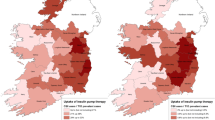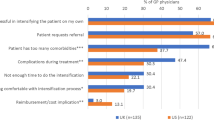Abstract
Aims
The uptake of continuous subcutaneous insulin infusion (CSII) is low in adults with type 1 diabetes mellitus (T1DM) in Ireland, compared to other countries where CSII is reimbursed. To explore the reasons for the low uptake, this study aims to investigate the availability of CSII in adult diabetes clinics in Ireland.
Methods
A national survey of all adult diabetes clinics (public and private) in Ireland was conducted and completed anonymously by the lead physician/diabetes nurse specialist in each clinic. Descriptive statistics and comparisons between clinics offering different levels of care for CSII are presented.
Results
Of 50 diabetes clinics invited, 47 (94%) participated in the study. Fifteen clinics (32%) offered no support for CSII, while 21 (45%) reported offering both training to commence CSII and ongoing support. Based on the survey findings, access to CSII was unavailable for 2426 (11%) of those with T1DM. The majority (n = 15,831, 71% of 22,321 T1DM population) received diabetes care from clinics offering CSII training, but only 2165 were using CSII (10% of T1DM population). Uptake of CSII was higher in clinics offering training than in those offering follow-up care for CSII only (12% vs. 5%, p < 0.001). Clinics offering all CSII services had more specialists (p = 0.005 for endocrinologists and p < 0.001 for dietitians). Reasons for not offering CSII services included staff shortages and heavy workload.
Conclusions
This study highlights the low uptake of CSII in Ireland and demonstrates that, even when reimbursed, other barriers to uptake of CSII can limit its use.


Similar content being viewed by others
References
Sherr JL, Tauschmann M, Battelino T et al (2018) ISPAD clinical practice consensus guidelines 2018: diabetes technologies. Pediatr Diabetes 19(Suppl 27):302–325. https://doi.org/10.1111/pedi.12731
Chiang JL, Kirkman MS, Laffel LMB, Peters AL (2014) Type 1 diabetes through the life span: a position statement of the American Diabetes Association. Diabetes Care 37(7):2034–2054. https://doi.org/10.2337/dc14-1140
Cummins E, Royle P, Snaith A et al (2010) Clinical effectiveness and cost-effectiveness of continuous subcutaneous insulin infusion for diabetes: systematic review and economic evaluation. Health Technol Assess 14(11):1. https://doi.org/10.3310/hta14110
Qin Y, Yang LH, Huang XL, Chen XH, Yao H (2018) Efficacy and Safety of Continuous Subcutaneous Insulin Infusion vs. Multiple Daily Injections on Type 1 Diabetes Children: a Meta-Analysis of Randomized Control Trials. J Clin Res Pediatr Endocrinol 10(4):316–323. https://doi.org/10.4274/jcrpe.0053
Phillip M, Battelino T, Rodriguez H et al (2007) Use of insulin pump therapy in the pediatric age-group: consensus statement from the European Society for Paediatric Endocrinology, the Lawson Wilkins Pediatric Endocrine Society, and the International Society for Pediatric and Adolescent Diabetes, endorsed by the American Diabetes Association and the European Association for the Study of Diabetes. Diabetes Care 30(6):1653–1662. https://doi.org/10.2337/dc07-9922
Bonfanti R, Lepore G, Bozzetto L et al (2016) Survey on the use of insulin pumps in Italy: comparison between pediatric and adult age groups (IMITA study). Acta Diabetol 53(3):403–412. https://doi.org/10.1007/s00592-015-0810-4
Toresson Grip E, Svensson AM, Miftaraj M et al (2019) Real-world costs of continuous insulin pump therapy and multiple daily injections for type 1 diabetes: a population-based and propensity-matched cohort from the Swedish National Diabetes Register. Diabetes Care 42(4):545–552. https://doi.org/10.2337/dc18-1850
Danne T, Bangstad HJ, Deeb L et al (2014) Insulin treatment in children and adolescents with diabetes. Pediatric Diabetes 15:115–134. https://doi.org/10.1111/pedi.12184
Repose Study Group (2017) Relative effectiveness of insulin pump treatment over multiple daily injections and structured education during flexible intensive insulin treatment for type 1 diabetes: cluster randomised trial (REPOSE). BMJ 356:j1285. https://doi.org/10.1136/bmj.j1285
Roze S, Smith-Palmer J, Valentine W, de Portu S, Norgaard K, Pickup JC (2015) Cost-effectiveness of continuous subcutaneous insulin infusion versus multiple daily injections of insulin in Type1 diabetes: a systematic review. Diabetic Med 32(11):1415–1424. https://doi.org/10.1111/dme.12792
Roze S, Cook M, Jethwa M, de Portu S (2014) Projection of long term health-economic benefits of sensor augmented pump (SAP) versus Pump Therapy Alone (CSII) in Type 1 Diabetes, a UK Perspective. Value Health 17(7):A348–A348
Šoupal J, Petruželková L, Grunberger G et al (2019) Glycemic outcomes in adults with T1D are impacted more by continuous glucose monitoring than by insulin delivery method: 3 years of follow-up from the COMISAIR study. Diabetes Care. https://doi.org/10.2337/dc19-0888
Jendle J, Pohlmann J, de Portu S, Smith-Palmer J, Roze S (2019) Cost-effectiveness analysis of the MiniMed 670G hybrid closed-loop system versus continuous subcutaneous insulin infusion for treatment of type 1 diabetes. Diabetes Technol Ther 21(3):110–118. https://doi.org/10.1089/dia.2018.0328
Duffus SH, Ta’ani ZA, Slaughter JC, Niswender KD, Gregory JM (2019) Increased proportion of time in hybrid closed-loop “Auto Mode” is associated with improved glycaemic control for adolescent and young patients with adult type 1 diabetes using the MiniMed 670G insulin pump. Diabetes Obes Metab. https://doi.org/10.1111/dom.13912
Diabetes Technology Network UK (2018) Best Practie Guide: Continuous subcutaneous insulin infusion (CSII). A clinical guide for adult diabetes services
Kampmann U, Madsen LR, Bjerg L et al (2018) Prevalence and geographical distribution of insulin pump therapy in the Central Denmark Region and its association with metabolic parameters. Diabetes Res Clin Pract 141:148–155. https://doi.org/10.1016/j.diabres.2018.04.042
Bruttomesso D, Costar S, Crazzolara D, Di Bartolo P, Girelli A, Tiengo A (2006) Continuous subcutaneous insulin infusion (CSII) in Italy. Diabetes Res Clin Pract 74:S130–S134. https://doi.org/10.1016/S0168-8227(06)70016-X
Carlsson BM, Andersson PN, Alnervik J, Carstensen J, Lind M (2012) Availability of insulin pump therapy in clinical practice. Diabet Med 29(8):1055–1059. https://doi.org/10.1111/j.1464-5491.2011.03517.x
Association of British Clinical Diabetologists, Diabetes UK JDRF, Diabetologists AoBC (2013) The United Kingdom Insulin Pump Audit—Service Level Data
Gajewska K, Biesma R, Bennett K, Sreenan S (2019) Barriers to accessing insulin pump therapy by adults with type 1 diabetes in Ireland: initial findings from a qualitative study. Ir J Med Sci 188:S227
Percentage of Population Covered by Private Health Insurance (2018) https://health.gov.ie/publications-research/statistics/statistics-by-topic/private-health-insurance/. Accessed 9 Aug 2019
Gueret M (2016) Irish Medical Directory 2015–2016. The doctor's book, 22 edn., Dublin
White HD, Goenka N, Furlong NJ et al (2014) The U.K. service level audit of insulin pump therapy in adults. Diabet Med 31(4):412–418. https://doi.org/10.1111/dme.12325
Bruttomesso D, Laviola L, Lepore G et al (2015) Continuous subcutaneous insulin infusion in Italy: third national survey. Diabetes Technol Ther 17(2):96–104. https://doi.org/10.1089/dia.2014.0242
van den Boom L, Karges B, Auzanneau M et al (2019) Temporal trends and contemporary use of insulin pump therapy and glucose monitoring among children, adolescents, and adults with type 1 diabetes between 1995 and 2017. Diabetes Care. https://doi.org/10.2337/dc19-0345
Healthcare Quality Improvement Partnership (2018) National diabetes insulin pump audit report, Main Report, 2016–2017. Government Statistical Service
Renard E (2010) Insulin pump use in Europe. Diabetes Technol Ther 12(1):29–32
Miller KM, Foster NC, Beck RW et al (2015) Current state of type 1 diabetes treatment in the U.S.: updated data from the T1D exchange clinic registry. Diabetes Care 38:971–978. https://doi.org/10.2337/dc15-0078/-/DC1
McCarthy MM, Grey M (2018) Type 1 diabetes self-management from emerging adulthood through older adulthood. Diabetes Care 41(8):1608–1614. https://doi.org/10.2337/dc17-2597
O’Donnell M, Smyth N, Dinneen S (2018) National survey of diabetes care delivery in acute hospitals. Health Service Executive, Dublin
Lepore G, Bonfanti R, Bozzetto L et al (2018) Metabolic control and complications in Italian people with diabetes treated with continuous subcutaneous insulin infusion. Nutr Metab Cardiovasc Dis 28(4):335–342. https://doi.org/10.1016/j.numecd.2017.12.001
Acknowledgements
We would like to thank Diabetes Ireland for their support in the survey preparation and data collection and all participants who completed the survey for the study.
Funding
This research was funded by the Health Research Board (HRB) SPHeRE/2013/1 as a part of the PhD programme, and KG is a HRB SPHeRE Programme scholar. KB is funded by a Health Research Board Award (RL-15-1579).
Author information
Authors and Affiliations
Corresponding author
Ethics declarations
Conflict of interest
The authors declare that they have no conflict of interest.
Ethical approval
All procedures performed in studies involving human participants were in accordance with the ethical standards of the institutional and/or national research committee of the Royal College of Surgeons in Ireland (RCSI) (Ethics reference no: 1445) and with the 1964 Helsinki Declaration and its later amendments or comparable ethical standards.
Informed consent
Informed consent was obtained from all participants at the time of completing the survey.
Additional information
Managed by Massimo Federici.
Publisher's Note
Springer Nature remains neutral with regard to jurisdictional claims in published maps and institutional affiliations.
Electronic supplementary material
Below is the link to the electronic supplementary material.
Appendix S1
STROBE Statement—checklist of items that should be included in reports of observational studies. (PDF 99 kb)
Appendix S2
Accessing insulin pump therapy and service by adults with Type 1 diabetes in Ireland. The National Survey—Finalized version 12/10/2017. (PDF 2016 kb)
Appendix S3
Reasons given for deciding whether to commence a person with diabetes on CSII therapy or not. (PDF 41 kb)
Rights and permissions
About this article
Cite this article
Gajewska, K.A., Biesma, R., Bennett, K. et al. Availability of and access to continuous subcutaneous insulin infusion therapy for adults with type 1 diabetes in Ireland. Acta Diabetol 57, 875–882 (2020). https://doi.org/10.1007/s00592-020-01497-6
Received:
Accepted:
Published:
Issue Date:
DOI: https://doi.org/10.1007/s00592-020-01497-6




